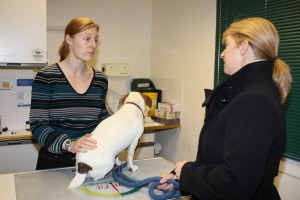A recent Veterinary Record publication looks at the behaviour of vets and clients when given the opportunity to discuss animal welfare.

VETS are placed in high regard by owners when entrusted with their pets’ welfare, however, animal welfare, as defined by the BVA’s Ethics and Welfare group ‘relates to both the physical health and mental wellbeing of the animal.’ It has been suggested that the veterinary profession could do more to provide behaviour support.1
A paper recently published in Veterinary Record carried out a ‘fly-on-the-wall’ investigation into animal welfare discussions, videoing 17 booster vaccination consultations, involving six vets, over two small animal practices and then asking the owner to fill out a post-consultation questionnaire.2 Clients tend to visit their practice when their pet is unwell, so a booster vaccination appointment was seen as a good opportunity to discuss welfare issues.
On reviewing the video consultations, authors Mandy Roshier and Anne McBride identified five main topics of discussion: navigation (ie, directing the consultation), medical, husbandry, behaviour and cost. The vets were found to instigate discussion on all of these topics with the exception of behaviour, which was found to be shared between the vets and clients – it was also the least discussed welfare topic. The subsequent owner questionnaire, however, revealed that all clients had concerns about at least one behaviour of their dogs and five clients indicated that they considered this behaviour ‘a big problem’. Only one client mentioned their concern (jumping up on people) to the vet and this was not fully explored. Another vet asked about a dog’s behaviour around other people; the client acknowledged that the dog was aggressive towards his wife but, again, the vet did not take this discussion any further.
The onus of identifying and reporting a behaviour issue lies with the owner, as it may not be obvious at the consultation, and the authors provide suggestions as to how vets can help to facilitate these discussions, such as developing trust and rapport, having a ‘safe’ environment to encourage disclosure and also creating opportunities to raise concerns.
Mandy had this to say: ‘In addition to vets, owners have the opportunity to access welfare information from a wide variety of sources, not all sources are reliable. In this study, behaviour concerns were not mentioned and this leads us to ask how, or if these concerns are being addressed. It is therefore important that vets enable their clients to discuss behaviour issues and provide appropriate support, be that directly or via referral.’
This study highlights areas that could be researched further to understand the practising of behavioural medicine. It is apparent, however, that vets and owners need to work together to provide the best possible welfare for their pets.
References: